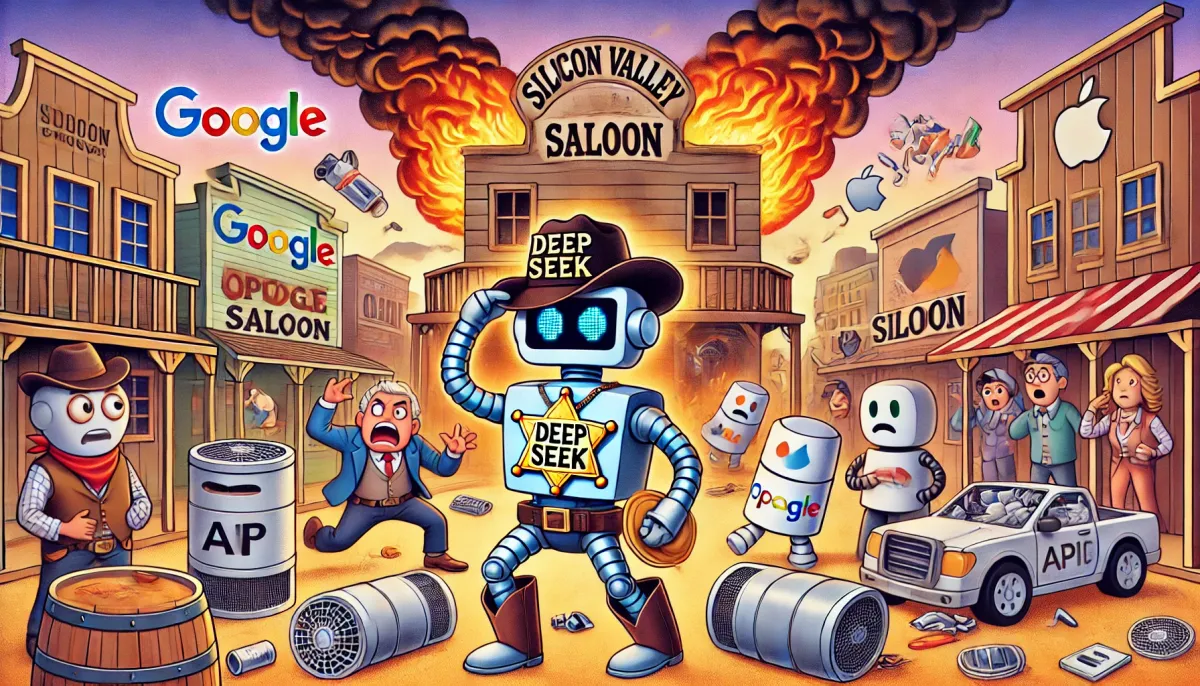DeepSeek r1: AI's Chaotic New Darling or the Harbinger of Digital Doom?

There’s a new sheriff in AI town, and its name is DeepSeek—a Chinese startup that has managed to do the impossible: simultaneously cause mass hysteria in Silicon Valley and become the No. 1 free app on the Apple Store. For those of you keeping score at home, that means it’s beating out Candy Crush, TikTok, and whatever app teens are using to share “study” playlists while they plot world domination.
But alas, even AI wunderkinds aren’t immune to the age-old adage: mo’ users, mo’ problems. As international attention swarmed their gloriously open-source R1 language model, DeepSeek found itself on the receiving end of some... let’s say, unwanted admirers. On Monday, the company had to slap a banner on their site reading, in what I imagine was a tone of quiet desperation:
“Due to large-scale malicious attacks on DeepSeek’s services, registration may be busy. Please wait and try again.”
This is tech-speak for: our servers are on fire, but don’t worry, it’s probably fine. A little later, they updated the note to say, “Go ahead and register, but it might still be a nightmare.” In the immortal words of every IT help desk ever: Have you tried turning it off and on again?
Attack of the Nerds (and Probably Governments)
DeepSeek didn’t exactly specify who’s behind the “large-scale malicious attacks,” but let’s be honest—when your tech is causing existential dread among U.S. companies, the list of potential culprits includes hackers, competitors, and possibly some guy named Carl who just really hates innovation.
Stephen Kowski, some tech-sounding guy with SlashNext (an AI security firm, because of course that’s a thing now), said DeepSeek’s sudden success is like blood in the water to “diverse threat actors.” Translation: if you’re an AI superstar, someone, somewhere is definitely trying to crash your party.
Naturally, the attacks haven’t stopped DeepSeek from basking in its newfound glory. Why would they? The R1 model is not only cheap—rumored to cost less than $6 million to train (basically the couch-cushion change of the AI world)—but it performs at a level that has OpenAI, Anthropic, and Google nervously glancing at their quarterly budgets like parents who just found out their kid joined a rock band.
But Wait, There’s Always a Catch
Now, before you start packing your bags for the AI utopia DeepSeek seems to promise, let’s talk about the fine print. First, there’s the pesky little matter of data privacy. Sure, the R1 model is free and open-source, but if you’re not hosting it locally, all your data is headed straight to servers in China. Yes, that includes your device model, operating system, keystroke patterns (why, though?), and crash reports—because nothing screams privacy-first like letting a foreign government potentially catalog your typos.
And let’s not forget the PRC-flavored bias baked into the model. If you’re looking for a chatbot to help you draft a scathing critique of President Xi Jinping, DeepSeek is not your friend. It’s as though the model politely says, “I’m sorry, Dave, I’m afraid I can’t do that.”
Silicon Valley: Shaken, Stirred, and Slightly Offended
The U.S. tech elite are not taking this well. After all, for years, they’ve been telling us that building high-performance AI requires obscene amounts of cash, servers the size of small countries, and an army of PhDs fueled by kombucha and existential dread. DeepSeek’s R1 just blew that narrative out of the water.
Ben Thompson, a tech analyst who probably has an espresso machine surgically attached to his arm, summed it up best:
“R1 undoes the o1 mythology... OpenAI does not have some sort of special sauce that can’t be replicated.”
Translation: OpenAI’s secret recipe might be less Colonel Sanders and more generic chicken nugget. Ouch.
What’s Next? A Low-Cost AI Arms Race?
With R1 proving that world-class AI doesn’t need a Scrooge McDuck vault of gold to work, the landscape is about to get a whole lot messier. If DeepSeek can deliver this level of performance for less than the cost of a single episode of The Mandalorian, what’s stopping other open-source models from following suit?
In the meantime, U.S. companies are scrambling to figure out if they can compete with a model that is free, runs on significantly lower compute power, and, oh yeah, is blowing up the Apple Store rankings. DeepSeek’s R1 might just be the canary in the coal mine—or the wrecking ball to the trillion-dollar castles Big Tech has built in the AI sky.
So, what have we learned? First, open-source is the gift that keeps on giving—and panicking people. Second, AI is the wild west, and DeepSeek is that mysterious stranger who just rolled into town, stirred up the saloon, and rode off with the sheriff’s hat. And third? Never underestimate the power of good PR, even if your servers are metaphorically held together with duct tape and the fervent prayers of an overworked engineering team.
Welcome to the future, folks. Try not to crash the servers.
Comments ()